There is no single highest sintering temperature. The maximum temperature for any sintering process is fundamentally determined by the material being consolidated. It is always a value below the material's melting point, as sintering is, by definition, a process of bonding particles together in the solid state.
The core principle is not to achieve the "highest" temperature, but the optimal temperature. This specific temperature enables maximum densification and strength by promoting atomic diffusion, without crossing the threshold into melting which would destroy the component's shape and internal structure.

The Governing Principle: Temperature as a Function of Melting Point
Sintering is a thermally activated process. The goal is to provide enough energy for atoms to move between particles, fusing them together and reducing porosity. This energy is directly related to the material's absolute melting temperature (Tm).
The General Rule of Thumb
As a starting point, effective sintering typically begins at temperatures greater than 0.6 times the material's absolute melting temperature (Tm), measured in Kelvin.
This rule highlights that materials with higher melting points, like tungsten or alumina, will require significantly higher sintering temperatures than materials like aluminum or polymers.
The True Upper Limit: The Melting Point
The absolute upper limit for any sintering operation is the melting temperature of the primary material. If you exceed this temperature, the process ceases to be sintering and becomes casting or melting.
The component will lose its structural integrity, slump under its own weight, and its carefully engineered microstructure will be destroyed. The goal is to get close enough to Tm to enable rapid diffusion without causing this failure.
Solid-State vs. Liquid-Phase Sintering
Solid-state sintering is the most common form, where the entire process occurs below the melting point of all constituent materials.
Liquid-phase sintering is a special case. It involves a mixture of powders where the furnace temperature is set above the melting point of a secondary, lower-melting-point material (a binder) but below the melting point of the primary structural material. The resulting liquid phase accelerates particle rearrangement and densification, often allowing for lower temperatures and shorter cycle times.
Understanding the Trade-offs: Why "Highest" Isn't "Best"
Pushing the sintering temperature too high, even if below the melting point, introduces significant risks and diminishing returns.
The Risk of Excessive Grain Growth
Temperature drives not only densification but also grain growth. While some grain growth is inevitable, excessive temperatures can cause grains to grow too large, which often leads to a decrease in the final component's mechanical properties, such as strength and toughness.
The Danger of Slumping and Deformation
As the temperature approaches the material's melting point, its stiffness and strength decrease dramatically. This "hot creep" can cause the component to distort, slump, or warp under gravity, especially for parts with complex geometries or thin walls.
Energy Costs and Equipment Demands
Higher temperatures require more energy, increasing operational costs. They also place greater demands on furnace materials, insulation, and heating elements, which can limit the maximum achievable temperature in a practical setting. For example, sintering tungsten (Tm ≈ 3422°C) requires highly specialized and expensive vacuum or hydrogen furnaces.
How to Apply This to Your Goal
Your ideal sintering temperature is a strategic choice based on your primary objective.
- If your primary focus is achieving maximum density: Your target is the highest possible temperature that does not cause unacceptable grain growth or component slumping.
- If your primary focus is cost-efficiency: You should use the lowest temperature that achieves the minimum required density and mechanical properties, potentially using liquid-phase sintering or sintering aids to accelerate the process.
- If your primary focus is preserving a fine-grained microstructure: You must use lower temperatures for longer times or employ advanced techniques like spark plasma sintering (SPS) to consolidate the part quickly before significant grain growth can occur.
Ultimately, mastering sintering is about precisely controlling temperature to achieve the desired material properties.
Summary Table:
| Sintering Factor | Key Consideration |
|---|---|
| General Starting Point | > 0.6 x Material's Melting Point (Tm) |
| Absolute Upper Limit | Material's Melting Point (Tm) |
| Primary Goal: Maximum Density | Highest temperature without slumping or excessive grain growth. |
| Primary Goal: Cost-Efficiency | Lowest temperature that meets required properties. |
| Primary Goal: Fine Microstructure | Lower temperatures or advanced techniques like SPS. |
Achieve Perfect Sintering Results with KINTEK
Determining the precise optimal temperature for your specific material and application is critical for success. KINTEK specializes in providing the advanced lab furnaces and expert consultation needed to master your sintering process.
We help our customers in research and industrial laboratories by:
- Providing reliable equipment capable of precise temperature control for a wide range of materials.
- Offering technical support to help you define the optimal thermal profile for your goals, whether it's maximum density, cost savings, or microstructural control.
Let's optimize your sintering process together. Contact our experts today to discuss your specific needs and how our solutions can bring value to your lab.
Visual Guide

Related Products
- 2200 ℃ Tungsten Vacuum Heat Treat and Sintering Furnace
- Vacuum Heat Treat and Sintering Furnace with 9MPa Air Pressure
- Laboratory Muffle Oven Furnace Bottom Lifting Muffle Furnace
- Dental Porcelain Zirconia Sintering Ceramic Furnace Chairside with Transformer
- Molybdenum Vacuum Heat Treat Furnace
People Also Ask
- Does sintering use diffusion? The Atomic Mechanism for Building Stronger Materials
- What is sintering reaction? Transform Powders into Dense Solids Without Melting
- What are the methods of brazing heating? Choose the Right Method for Your Production Needs
- What are the defects in sintered parts? Avoid Warping, Cracking, and Porosity Issues
- What is vacuum sintering? Achieve Unmatched Purity and Performance for Advanced Materials



















